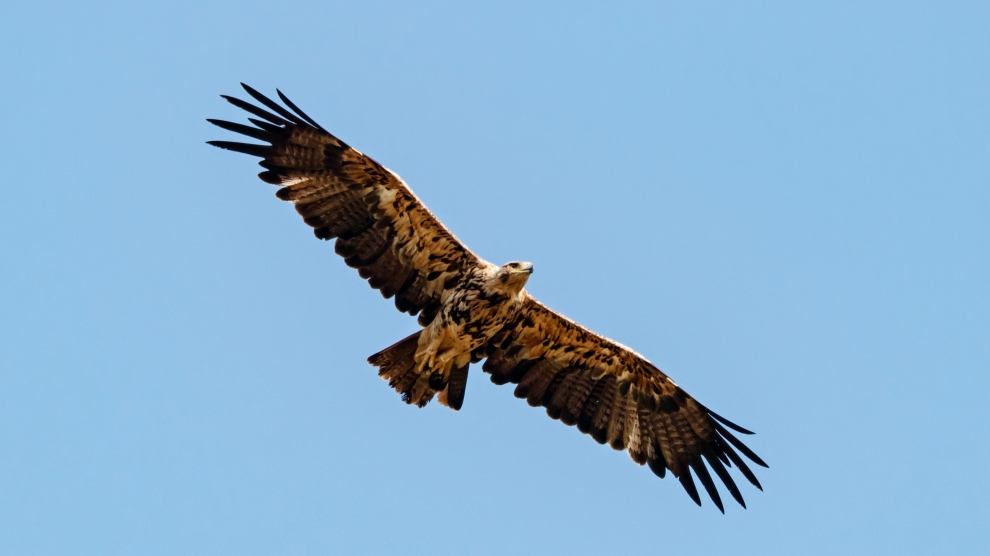There are now three new nesting pairs of the eastern imperial eagle in Serbia, representing a huge victory for the conservation movement in the country.
The eastern imperial eagle is the most endangered bird in Serbia, and is threatened throughout much of southeastern Europe. Loss of habitat due to deforestation is the main driver of the bird’s population decline.
According to the Bird Protection and Study Society of Serbia (BPSSS) the three new pairs are a result of a three year-long effort to protect the nest of the only pair known to exist in Serbia in 2017.
Volunteers kept watch to make sure the birds were not disturbed during the most sensitive times of the year – when the eagles are rearing their young.
The effort paid off, as five fledgelings have been seen leaving the nest and making nests of their own during the three-year period.
“I am happy and very proud that after the long years of anxiety and uncertainty [about the imperial eagle population] we can say today that the eastern imperial eagle is coming back to Serbian skies,” says Milan Ružić, executive director of BPSSS.
There is a symbolic significance in the conservation effort, as the eastern imperial eagle is thought to have been the inspiration for the eagle found on the official Serbian coat of arms. The eagle is also one of the official birds of the nation.
The effort to conserve the eagles was supported by the European Commission as part of the PanonEagle LIFE project that also involves expert organisations from the region.
“We applied the experiences of our Hungarian colleagues who have been successfully working on eastern imperial eagle conservation for the past 40 years,” Mr Ružić explains.
But while the three new pairs represent a victory for conservationists, the troubles of the eastern imperial eagle are far from over.
Slobodan Knežević, a conservationist from the BPSSS, says that there are multiple factors at play which made the bird so endangered in the first place.
“Loss of habitat, poisoning, and poaching are the problems that brought the eastern imperial eagle to the edge of extinction. The european ground squirrel [Spermophilus citellus, native to Eastern Europe and Asia Minor], a favourite food of the eagle, lives in open grassy fields, most often pastures that have been plowed over due to the dying off of traditional animal husbandry. There are no cows grazing, no pastures, no ground squirrel, no old trees that can withstand the nests of these large birds, so there are no imperial eagles. When you add in pesticides and poaching, the state of the population is not surprising,” he says.
Reckless pesticide use is very bad for the birds, but Serbia also faces the issue of intentional poisoning of wildlife.
Mr Knežević says that BPSSS has recorded 321 cases of intentional bird poisoning so far. In 2018, a dead female imperial eagle was found by the organisation. The perpetrator has still not been identified.
The biggest issue that makes conservation hard is deforestation. The Serbian province of Vojvodina, where the eagles make their home, is the least forested region in Europe.
Despite this, a provincial budget adjustment has cut all funding to reforestation efforts – prompting outrage and criticism from environmental activists.
“This kind of behaviour is tragic and unsustainable,” said a press release from the Reforest Vojvodina NGO network.
Reforestation is especially important for the eagles, as they require old and sturdy trees to build their nests. Since such trees are scarce in Vojvodina, BPSSS activists have taken to placing man-made metal platforms to aid in the nesting.
When it comes to consciousness about the importance of conservationism among the citizens and institutions, Mr Knežević says the institutions are lagging behind.
“When it comes to decision makers, often the heads of such institutions are politicians who don’t seem to understand the importance of biodiversity. They do offer support, but it’s more declarative than proactive. We hope that decision makers will also start to listen to the interests of nature because that will make their policies sustainable,” Mr Knežević tells Emerging Europe.
Even though structural issues remains, it’s clear that BPSSS is emboldened by its recent success. It is now planning to tag one of the fledglings with a satellite transmitter to better understand the behaviour of the birds once they leave their nests.
In addition, BPSSS has taken further measures that will help with the conservation of eastern imperial eagles.
“This year we set up metal nesting platforms, continued with the mowing of overgrown pastures, started planting trees and supplying prey,” Mr Knežević says.
The effort to conserve the population of eastern imperial eagles in Serbia is far from being concluded – but the recent news helped raise awareness of the problem ahead of the International Day for Biological Diversity on May 22. There is still uncertainty, but it seems better days are ahead for the endangered eastern imperial eagle.
—
Unlike many news and information platforms, Emerging Europe is free to read, and always will be. There is no paywall here. We are independent, not affiliated with nor representing any political party or business organisation. We want the very best for emerging Europe, nothing more, nothing less. Your support will help us continue to spread the word about this amazing region.
You can contribute here. Thank you.









Add Comment